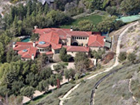
History of the University of North Carolina at Chapel Hill
USINFO | 2014-10-30 10:35

Beginnings: Late 18th century
Chartered by the North Carolina General Assembly on December 11, 1789 and beginning instruction in 1795, the University of North Carolina at Chapel Hill (then named simply the University of North Carolina) is the oldest public university in the nation, as measured by start of instruction as a public institution. The College of William & Mary, chartered in 1693, and the University of Georgia, chartered in 1785, are both older as measured by date of charter. However, William & Mary was originally a private institution, and did not become a public university until 1906. Georgia has always been a public institution, but did not start classes until 1801. A political leader in revolutionary America, William Davie led efforts to build legislative and financial support for the university.
UNC course catalog from June, 1819
The university opened in a single building, which came to be called Old East. Still in use as a residence hall, it is the oldest building originally constructed for a public university in the United States. Davie, in full Masonic Ceremony as he was the Grand Master of the Grand Lodge of North Carolina at the time, laid the cornerstone on October 12, 1793, near an abandoned Anglican chapel which led to the naming of the town as Chapel Hill. The spot was chosen due to its geographic centrality in the state. The first student, Hinton James, arrived on foot from Wilmington on February 12, 1795. While a student, James founded the Dialectic Society. A dormitory on the UNC campus is named in his honor. It is currently the southern-most on-campus dormitory and houses primarily first-years.
Growth and development: Early 19th century
The early 19th century saw a period of much growth and development with the help of the backing of the trustees. Through this growth, the university began to move away from its original purpose, to train leadership for the state, as it added to the curriculum, first starting with the typical classical trend. By 1815, the university started giving equal ground to the natural sciences. This development continued with the establishment of the first astronomical observatory at a state university in 1831.
American Civil War: Late 19th century
Original Old Well 1892
During the Civil War, the university was among the few in the Confederacy that managed to keep its doors open. Soon thereafter, however, the university was forced to close during Reconstruction from 1870 until 1875 due to lack of students and funding. After North Carolina's readmission to the Union in 1868, new political leaders came to power. They attempted to change the direction of the University through political appointments, but these were blocked. The University resumed growth and innovation, opening the first university summer school in America, and continued to develop scientific programs, establishing regular medical and pharmaceutical offerings by 1879.
Consolidation: Early 20th century
In 1932, UNC became one of the three original campuses of the consolidated University of North Carolina (since 1972 called the University of North Carolina system). During the process of consolidation, programs were moved among the schools, which prevented competition. For instance, the engineering school moved from UNC to North Carolina State University in Raleigh in 1932. In 1963 the consolidated university was made fully coeducational. As a result, the Woman's College of the University of North Carolina was renamed the University of North Carolina at Greensboro, and the University of North Carolina itself became the University of North Carolina at Chapel Hill.
Chartered by the North Carolina General Assembly on December 11, 1789 and beginning instruction in 1795, the University of North Carolina at Chapel Hill (then named simply the University of North Carolina) is the oldest public university in the nation, as measured by start of instruction as a public institution. The College of William & Mary, chartered in 1693, and the University of Georgia, chartered in 1785, are both older as measured by date of charter. However, William & Mary was originally a private institution, and did not become a public university until 1906. Georgia has always been a public institution, but did not start classes until 1801. A political leader in revolutionary America, William Davie led efforts to build legislative and financial support for the university.
UNC course catalog from June, 1819
The university opened in a single building, which came to be called Old East. Still in use as a residence hall, it is the oldest building originally constructed for a public university in the United States. Davie, in full Masonic Ceremony as he was the Grand Master of the Grand Lodge of North Carolina at the time, laid the cornerstone on October 12, 1793, near an abandoned Anglican chapel which led to the naming of the town as Chapel Hill. The spot was chosen due to its geographic centrality in the state. The first student, Hinton James, arrived on foot from Wilmington on February 12, 1795. While a student, James founded the Dialectic Society. A dormitory on the UNC campus is named in his honor. It is currently the southern-most on-campus dormitory and houses primarily first-years.
Growth and development: Early 19th century
The early 19th century saw a period of much growth and development with the help of the backing of the trustees. Through this growth, the university began to move away from its original purpose, to train leadership for the state, as it added to the curriculum, first starting with the typical classical trend. By 1815, the university started giving equal ground to the natural sciences. This development continued with the establishment of the first astronomical observatory at a state university in 1831.
American Civil War: Late 19th century
Original Old Well 1892
During the Civil War, the university was among the few in the Confederacy that managed to keep its doors open. Soon thereafter, however, the university was forced to close during Reconstruction from 1870 until 1875 due to lack of students and funding. After North Carolina's readmission to the Union in 1868, new political leaders came to power. They attempted to change the direction of the University through political appointments, but these were blocked. The University resumed growth and innovation, opening the first university summer school in America, and continued to develop scientific programs, establishing regular medical and pharmaceutical offerings by 1879.
Consolidation: Early 20th century
In 1932, UNC became one of the three original campuses of the consolidated University of North Carolina (since 1972 called the University of North Carolina system). During the process of consolidation, programs were moved among the schools, which prevented competition. For instance, the engineering school moved from UNC to North Carolina State University in Raleigh in 1932. In 1963 the consolidated university was made fully coeducational. As a result, the Woman's College of the University of North Carolina was renamed the University of North Carolina at Greensboro, and the University of North Carolina itself became the University of North Carolina at Chapel Hill.
Share this page



















